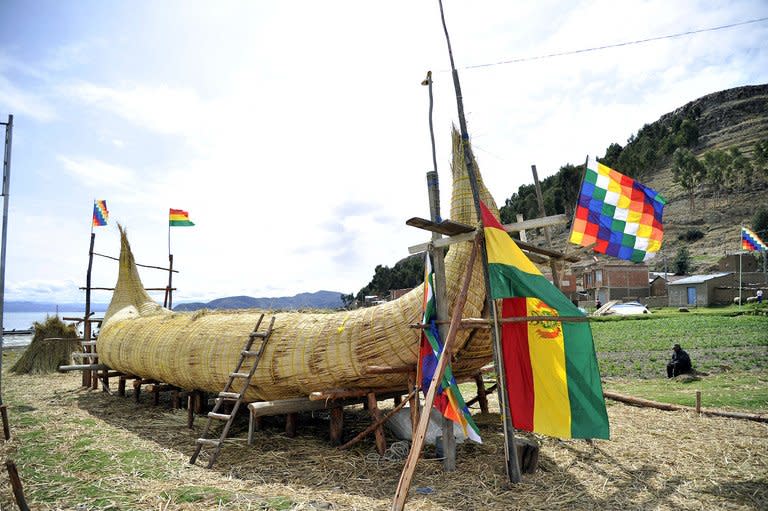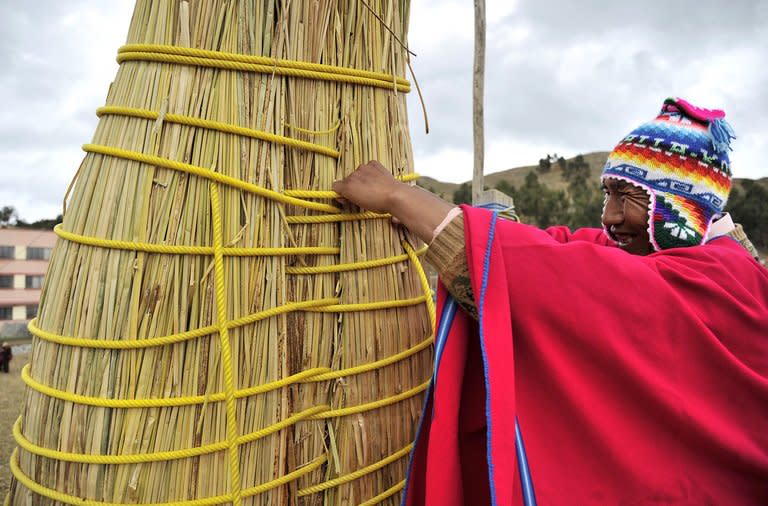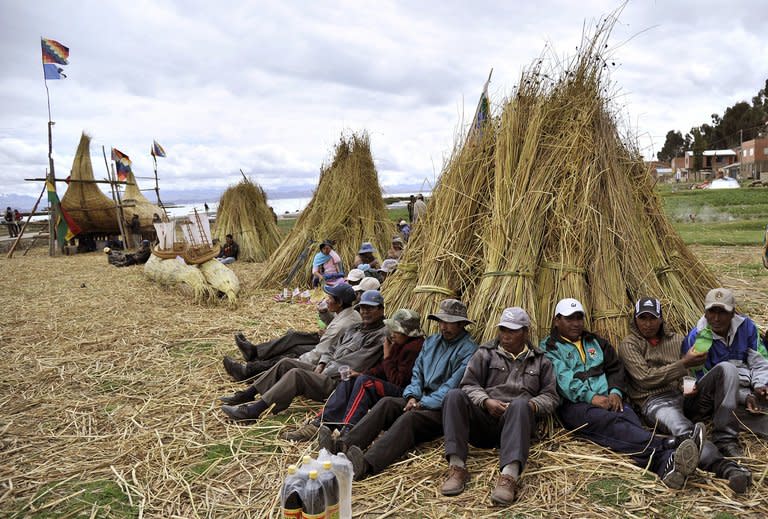Bolivia's eco-friendly trans-oceanic ships
The Limachi family specializes in building eco-friendly reed ships at this shipyard on the top of the world with pre-Columbian technology. But don't be fooled -- these ships can sail across vast oceans. Ships built of bullrush reed, known here as totora, have sailed the Pacific, the Atlantic, the Mediterranean, and for a millennia across the Titicaca, the vast Andean lake 4,700 meters (15,420 feet) above the sea level shared by Bolivia and Peru. The Limachis and other Aymara native residents of Suriqui Island have built 22 trans-oceanic reed vessels over the past decades, and if funding comes through, will build a ship they hope will sail from New York to Spain in 2014. Foreign Minister David Choquehuanca, an Aymara native, recently visited Suriqui Island to inspect the Thunupa, a reed ship shaped like a Viking longboat about 14 meters long that the Limachis helped build. "When you lay down on a totora boat, it feels like you're levitating," Choquehuanca told reporters. The Thunupa, named after an ancient Andean deity, will sail around Lake Titicaca on December 21 for an Andean ceremony marking the summer solstice in the southern hemisphere, a key date in Aymara cosmology. The family patriarch, Demitrio Limachi, has helped build the most famous reed boats of the past decades. These include the Ra II, which Norwegian adventurer Thor Heyerdahl used to sail between Morocco and the Barbados Islands in the Caribbean in 1970. The Ra II is on display at the Kon-Tiki Museum in Oslo. (Heyerdahl's other famous ship, the Kon-Tiki, was a balsa raft that he used in 1947 to sail from Peru to the Polynesian islands). Also famous is the Viracocha II, which sailed in 2003 with an American crew from Chile to the Easter Island, the remote Pacific island renown for its mysterious giant stone heads. The Bolivian-built Abora II sailed in 2002 between Egypt, Lebanon and Cyprus to show that ancient mariners could navigate the Mediterranean. Totora reeds are similar to reeds found on the Nile, and the Titicaca inhabitants are among the few in the world who know how to build such vessels. Another totora ship, the Abora III, sailed from New York in 2007 in an attempt to show that there could have been pre-historic communication from the Americas to the Old World, but its sailors had to give up before reaching the Azores when the ship was damaged. The attempt was led by German archeologist Dominique Gorlitz. The Thunupa is similar to the Abora IV, a ship that -- if funding comes through -- will be built late next year in New York. Plans are for Gorlitz to use it for his second attempt to sail to Spain via the Canary Islands. "We will be taking totora from Lake Titicaca up to New York" to build the ship, Porfirio Limachi, a member of the extended family, told AFP, adding that he will be part of the expedition's multi-national crew. Plans are for Porfirio and his team to start building the Abora IV around August 2013 for an expedition that would set sail in May or June 2014. Here on Suriqui, the island's 1,000 residents divide their time between fishing, handicrafts and building boats, said Esteban Callisaya, a community leader. Today most of the island residents get around on fiberglass or metal boats with outboard motors. The advantages are obvious: the modern boats move faster and last much longer than the reed ships. And yet there is still plenty of work for the Limachis building totora boats, whether for museums in places like South Korea, the United States and Spain, or for trans-oceanic expeditions by daring adventurers. The basic totora ship building material is a reed stalk, which can measure up to 2.5 meters long. Locals also use the sturdy reeds, which grow in the shallow parts waters of Lake Titicaca to build roofs. Native Uro people, mostly on the Peruvian side of the lake, live on floating islands made entirely of totora. "With this material we assemble the rolls that make up the body of these vessels," said Porfirio's cousin Fermin Limachi, also 45. "Our ancestors did not use measuring tape or weights," he said, explaining that instead they use extended arms, hands and fingers as a basis for measurements. The reeds are harvested, sorted by length and placed to dry out in the high mountain air for two months. The builders the gather 300 to 400 totora stalks, tie them into bundles with tough mountain straw, tighten the bundles with a wooden hook, then use heavy oval stones to press the reeds bundles together to form larger bundles. It usually takes a team of 30 to 50 people about three months to build a ship like the Thunupa, said Porfirio Limanchi. Once complete, a ship has room for up to 25 people. Fermin Limachi claims that Bolivian totora is of higher quality than reed found in places like, for example, Lake Chad in Africa, where fishermen also build reed boats. "It is lighter, it has more fiber, it retains has more oxygen, it a better ability to float and most importantly it has a longer useful life," he said. "While other reeds last three to four months in the water, totora will last more than eight months." Demetrio Limachi, the 45 year-old son of the eponymous clan patriarch, is proud to carry on the family tradition. "My father only went to school up to third grade," Demetrio told AFP. "He knew nothing about physics or geometric calculations, but he built boats with the knowledge he inhereted from his forefathers." Limachi was destined to go into the family business from an early age -- his first toy was a tiny totora boat, which he still has.




